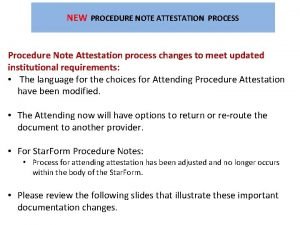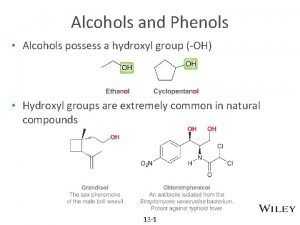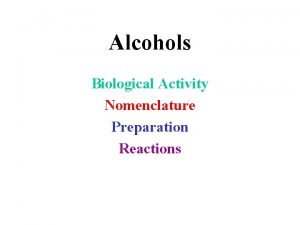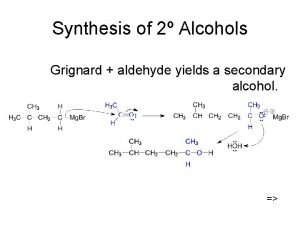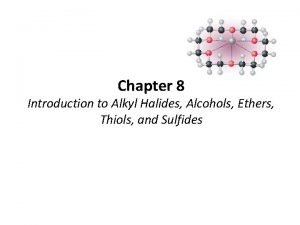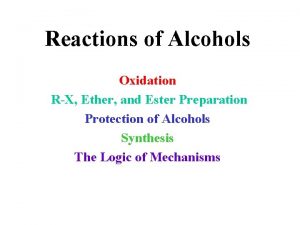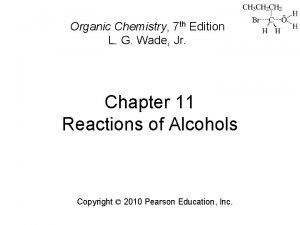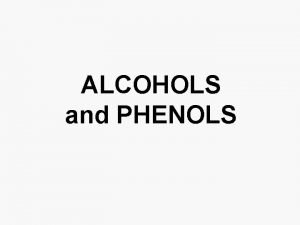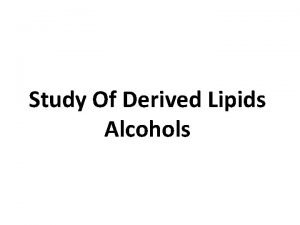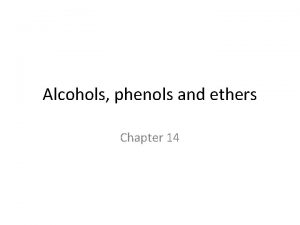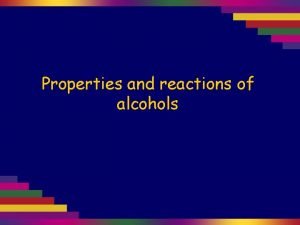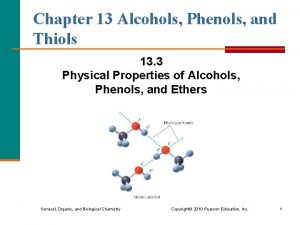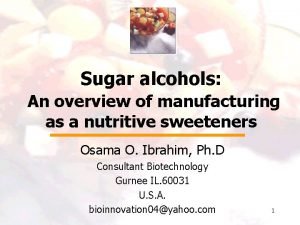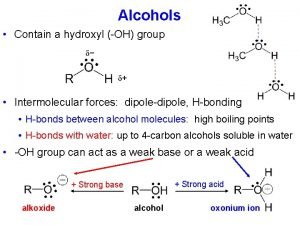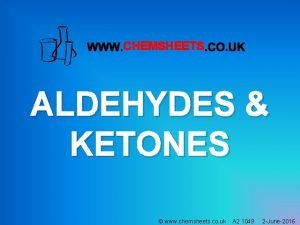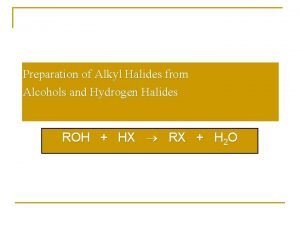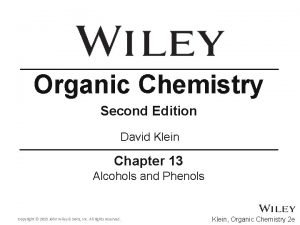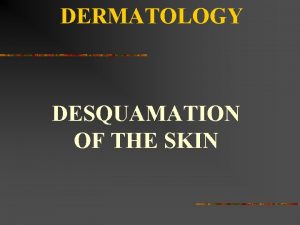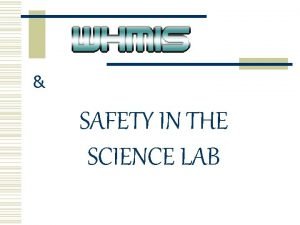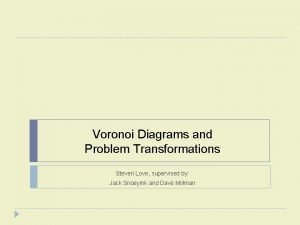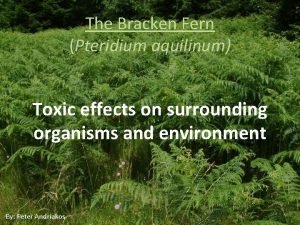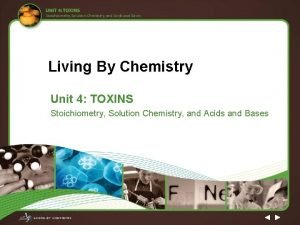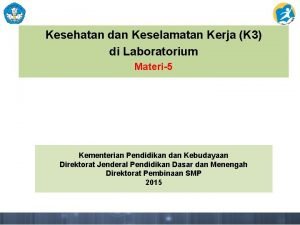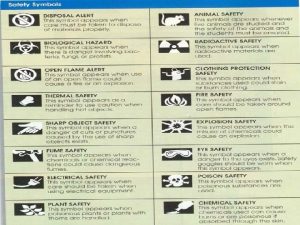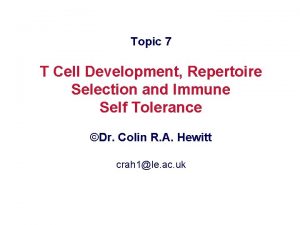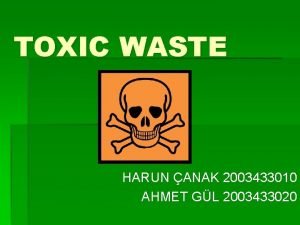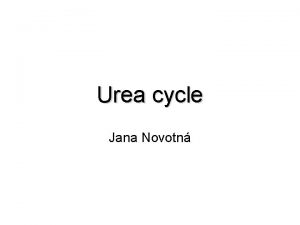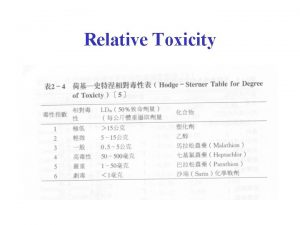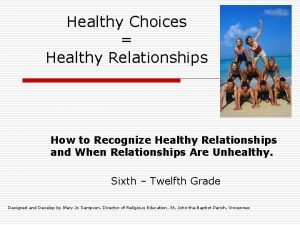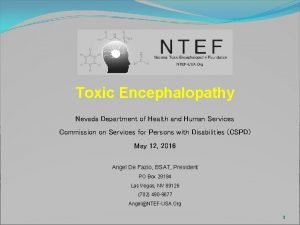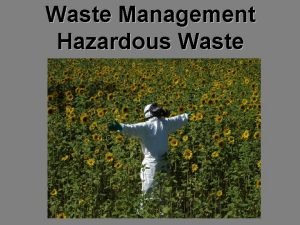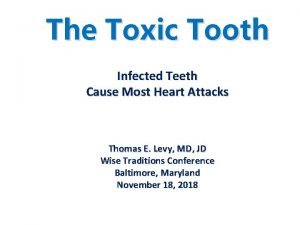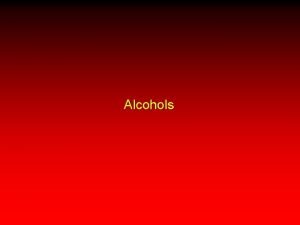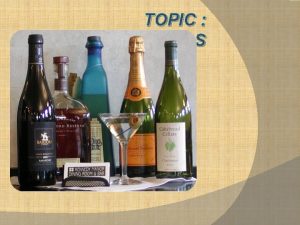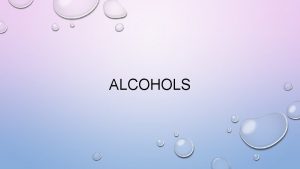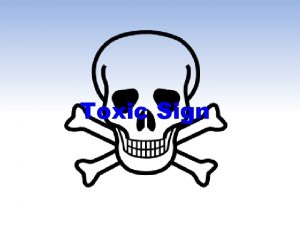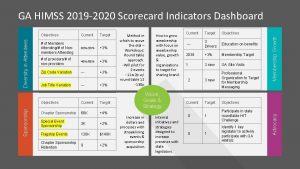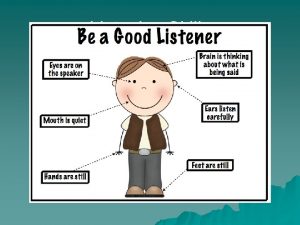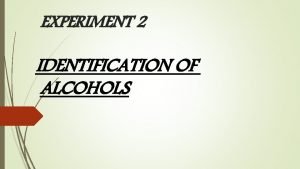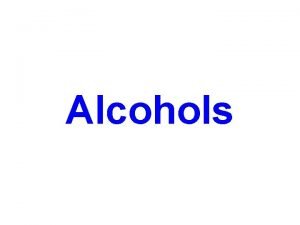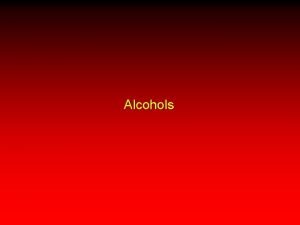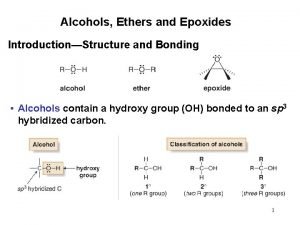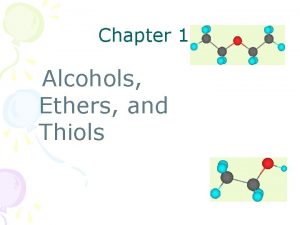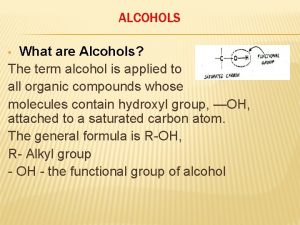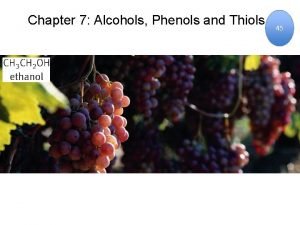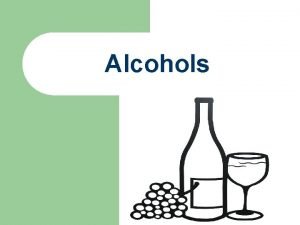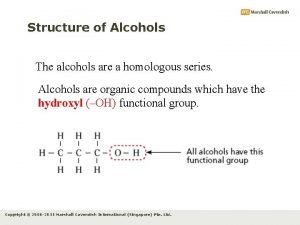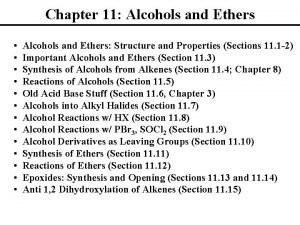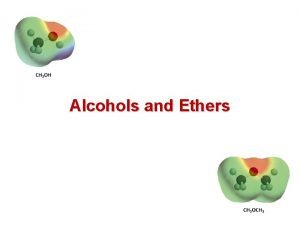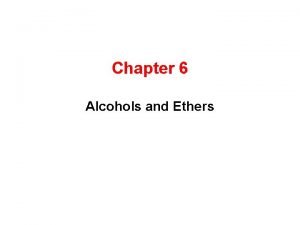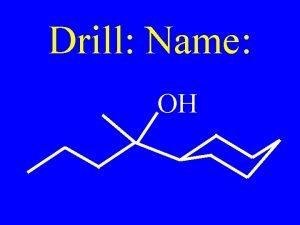Toxic Alcohols John Kashani D O Attending St
























































- Slides: 56

Toxic Alcohols John Kashani D. O. Attending, St. Joseph’s Emergency Department Staff Toxicologist, New Jersey Poison Center

Case • An 18 year old male is brought into the ED by his mother when he was difficult to awaken in the AM • He was partying the night before, he is not able to provide a history • He becomes progressively more obtunded while in the ED

Case • A 22 year old frustrated medical student drinks a bottle of formaldehyde he stole from gross anatomy lab • He complains of throat and esophageal irritation and has had multiple episodes of emesis

Case • A 65 year old man is found comatosed • His wife states that he has been depressed recently and has been drinking heavily • An empty bottle of antifreeze was found in his kitchen garbage can

Case • A 17 year old female ingests a bottle of rubbing alcohol • She appears drunk, has multiple episodes of emesis and complains of abdominal pain

Case • A 25 year old man presents to the ED with blurry vision • For the past few days he has been feeling “cruddy” • He admits to the ingestion of homemade everclear 3 days prior

Objectives • Outline the “toxic” alcohols and potentially toxic alcohols • Discuss the pharmacology, kinetics and pathophysiology of the toxic alcohols • Discuss the clinical manifestations, diagnosis and management of patients poisoned by these agents

Introduction • Alcohols are hydrocarbons that contain a hydroxyl group • A compound with two hydroxyl groups is called a diol or a glycol • Toxic alcohols commonly refer to methanol, ethylene glycol and isopropyl alcohol

Introduction • Less common but potentially toxic alcohols include diethylene glycol, benzyl alcohol and the glycol ethers


Ethylene Glycol • • Coolant mixtures Antifreeze Air craft de-icing solutions Solvent (inks, pesticides and adhesives) Brake fluid Heat exchangers and condensers Glycerin substitute

Propylene glycol • Commonly used as a diluent for parental preparations • Environmentally safe alternative to ethylene glycol antifreeze

Benzyl alcohol +

Methanol • • Antifreeze (window washer fluid) Anti icing agent Octane booster Ethanol denaturant Extraction agent Solvent Fuel source

Methanol • Varnish and paint removers • Industrial solvent • Manufacture of acetic acid, formaldehyde and inorganic acids

Isopropanol • • • Synthesis of acetone, glycerin Solvent for oils, gums and resins Deicing agent Rubbing alcohol Hair care products, skin lotion and aerosols

Diethylene glycol • Solvent • Sprinkler antifreeze • Paints, cosmetics + HEAA

Glycol ethers • • • Solvents Semiconductor industry Fingernail polishes and removers Dyes, ink, cleaners, degreasers Brake fluid, car wax, injector cleaner Various household cleaning products

Pharmacology and Kinetics • Exposure may occur dermally, pulmonary and GI – Pulmonary absorption depends on vapor pressure • Rapidly absorbed by the gastrointestinal route

Pharmacology and Kinetics • Time to peak concentration – Ethylene glycol = 1 - 4 hrs – Methanol, isopropyl alcohol = 30 - 60 minutes • VD is 0. 6 L/kg

Pharmacology and Kinetics • Ethylene glycol and methanol are metabolized by alcohol dehyrogenase and aldehyde dehydrogenase • Isopropanol is metabolized by alcohol dehydrogenase • Binding affinities for – ethanol>methanol>ethylene glycol

Pharmacology and Kinetics • Methanol metabolism may be delayed (up to 72 hours) • The volatility of methanol contributes to its pulmonary excretion (10 -20%) • Ethylene glycol is metabolized over 3 – 8 hours – Undergoes multiple oxidations

Pharmacology and Kinetics • Ethylene glycol is not appreciably excreted by the lungs • Isopropanol is rapidly metabolized to acetone via alcohol dehyrogenase • 20% is excreted unchanged • Acetone is predominantly renally excreted

(CH 2 OH)2 Ethylene glycol ADH CH 2 OHCHO Glycoaldehyde ADH CH 2 OHCOOH Glycolic Acid ADH CHOCOOH thiamine Mg++ Alpha-hydroxy-betaketoadipic acid Glyoxylic Acid B 6 Oxalic Acid Glycine + Benzoic Acid Hippuric Acid

CH 3 OH Methanol ADH CH 2 O Formaldehyde ADH CHOOH Folate CO 2 + H 2 O Formic Acid

CH 3 CHOHCH 3 Isopropyl alcohol ADH CH 3 COCH 3 Acetone

The Usual Suspects

Formic acid • Metabolic acidosis • Inhibits cytochrome oxidase: – Decreased ATP production • Increased anaerobic glycolysis & lactate

NAD+ NADH + H+ R-OH ADH

NADH H+ Pyruvate NAD+ Lactate NAD+ NADH H+ CO 2 Acetyl-Co. A NADH NAD+

Clinical Manifestations • Clinical manifestations may be related to the parent compound or metabolites • There may be an initial asymptomatic period • Inebriation (unreliable) – Isopropyl>ethylene glycol>methanol

Clinical Manifestations • Vasodilation – hypotension and reflex tachycardia • Hypoglycemia • Anion gap acidosis – Methanol and ethylene glycol • Visual disturbances (”snow Field”) – Formic acid is a retinal toxin

Clinical Manifestations • ATN may develop secondary to calcium oxalate crystalluria • Cranial nerve deficits have been reported with ethylene glycol

Clinical Manifestations • Ispopropanol ingestion usually does not cause major toxicity unless a large amount is ingested – CNS depression, hemorrhagic gastritis and tracheobronchitis

Diagnosis • Both ethylene glycol and methanol result in an anion gap acidosis • Isopropyl alcohol usually does not result in an anion gap acidosis • Hypocalcemia may be seen in ethylene glycol intoxication – Chelation of calcium by oxalate – calcium oxalate crystals

Diagnosis • The absence of crystals is an unreliable finding • The urine of a patient with ethylene glycol ingestion may fluoresce – Short lived, unreliable

Calcium oxalate Crystals

The “Osmolar Gap” Measured Serum Osmolarity Minus Calculated Serum Osmolarity [ 2(NA) + BUN/2. 8 + Glucose/18+Etoh/4. 6]

Substance Methanol Ethylene glycol Acetone Isopropanol Salicylate * At 100 mg/dl Mole Wgt 32 46 62 58 60 180 m. Osm/L* 34 23 19 18 18 6


AG m. Osm m. Eq/L OG 0 Time since Ingestion

Quantitative testing • If quantitative levels are readily available they can be used to determine proper management • Best method is gas chromatography with flame ionization – Subject to false positives

Management • • ABC’s +/---- NGT aspiration AC/ipecac/lavage = Bad move Thiamine and pyridoxine in the setting of ethylene glycol toxicity • Folic acid in the setting of methanol toxicity

Management • Sodium bicarbonate as needed • Inhibition of Alcohol dehydrogenase – Ethanol – Fomepizole

Ethanol vs Fompepizole Ethanol: - Oral or IV - CNS depression - Difficult titration - Frequent levels - Hypoglycemia Fomepizole: - IV - No CNS depression - Easy dosing - No levels to monitor - More predictable pharmacokinetcs - No Hypoglycemia - Cost

Fomepizole…because shit happens

(CH 2 OH)2 X Ethylene glycol ADH CH 2 OHCHO Glycoaldehyde ADH CH 2 OHCOOH Glycolic Acid ADH Thiamine 100 mg IV/day Mg++ Alpha-hydroxy-betaketoadipic acid CHOCOOH Glyoxylic Acid B 6 100 mg/day Oxalic Acid Glycine + Benzoic Acid Hippuric Acid

CH 3 OH X Methanol ADH CH 2 O Formaldehyde ADH CHOOH Folate CO 2 + H 2 O Formic Acid

Case • An 18 year old male is brought into the ED by his mother when he was difficult to wake up in the AM • Apparently he was partying the night before, he is not able to provide a history • He becomes progressively more obtunded while in the ED

Case • A 22 year old frustrated medical student drinks a bottle of formaldehyde he stole from gross anatomy lab • He complains of throat and esophageal irritation and has had multiple episodes of emesis

Case • A 65 year old man is found comatosed • His wife states that he has been depressed recently and has been drinking heavily • An empty bottle of antifreeze was found in his kitchen garbage can

Case • A 17 year old female ingests a bottle of rubbing alcohol • She appears drunk, has multiple episodes of emesis and complain of abdominal pain

Case • A 25 year old man presents to the ED with blurry vision • For the past few days he has been feeling “cruddy” • He admits to the ingestion of homemade everclear 3 days prior

Toxic alcohol Pearls • Calcium oxalate crystals, renal failure = ethylene glycol • “Snow field vision” = methanol • Methanol has a slower metabolism and there may be a significant lag until the onset of symptoms • A “normal” osmolar gap does not rule out the diagnosis

Toxic alcohol Pearls • “ketosis without acidosis” = isopropyl alcohol • Inhibition of alcohol dehydrogenase with fomepizole

The End
 Ispopropanol
Ispopropanol Hamed kashani
Hamed kashani Attending responding personalizing initiating
Attending responding personalizing initiating Teacher iii meaning
Teacher iii meaning Thank you for attending open house
Thank you for attending open house Aper attestation
Aper attestation Attending vs resident
Attending vs resident Why is attending school important
Why is attending school important Pcc with aldehyde
Pcc with aldehyde Na2cr2o7 mechanism
Na2cr2o7 mechanism Alcohol to aldehyde
Alcohol to aldehyde Alcohols nomenclature
Alcohols nomenclature Lucas reagent is
Lucas reagent is Lucas reagent is
Lucas reagent is Acidity of alcohols
Acidity of alcohols These are alcohols containing cppp nucleus
These are alcohols containing cppp nucleus Alcohols nomenclature
Alcohols nomenclature Chlorination
Chlorination Alcohols phenols thiols and ethers
Alcohols phenols thiols and ethers Relative sweetness chart
Relative sweetness chart Formation of alcohols
Formation of alcohols Ethanol to ethanal to ethanoic acid
Ethanol to ethanal to ethanoic acid Butanone + acidified kcn
Butanone + acidified kcn Preparing haloalkanes from alcohols
Preparing haloalkanes from alcohols Alcohols nomenclature
Alcohols nomenclature Primary and secondary alcohol oxidation
Primary and secondary alcohol oxidation Toxicology
Toxicology Fimmta veikin
Fimmta veikin Non toxic ceramic paint
Non toxic ceramic paint Toxic leadership styles
Toxic leadership styles Toxic school culture
Toxic school culture Mixoedema
Mixoedema Toxic symbol
Toxic symbol Toxic waste dump problem voronoi
Toxic waste dump problem voronoi How toxic is bracken fern
How toxic is bracken fern Toxic reactions chemical equations
Toxic reactions chemical equations Very toxic
Very toxic Popcorn lesson plans
Popcorn lesson plans Healthy vs unhealthy relationship scenarios
Healthy vs unhealthy relationship scenarios Toxic substances control
Toxic substances control Toxic
Toxic Where does negative selection occur
Where does negative selection occur Toxic waste causes
Toxic waste causes Copyright ppt
Copyright ppt Ammonia toxic
Ammonia toxic Which is more toxic
Which is more toxic Toxic communication
Toxic communication Identifying toxic people
Identifying toxic people The history of grading practices
The history of grading practices Non toxic revolution
Non toxic revolution Toxic triangle of destructive leadership
Toxic triangle of destructive leadership Acute toxic encephalopathy icd 10
Acute toxic encephalopathy icd 10 Sample of hazardous waste
Sample of hazardous waste The toxic tooth levy
The toxic tooth levy Toxic mentoring
Toxic mentoring Toxic trio nspcc
Toxic trio nspcc Toxic reactions chemical equations lesson 68 answers
Toxic reactions chemical equations lesson 68 answers





